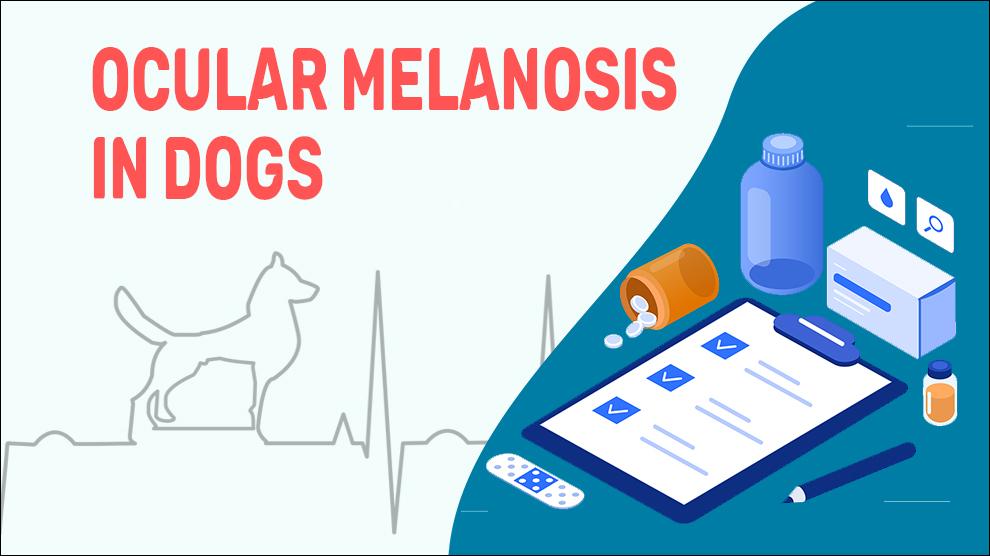Ocular melanosis (OM) is a congenital, possibly autosomal-dominant, pigmentary lesion that is in a form of a nevus (mole) with an unpredictable age of onset and variable rate of progression.
Also known as conjunctival hypomelanosis, the nevus is located in deep in the uveal tract, sclera, and episclera. This may clinically manifest as iris heterochromia (different colored iris) and an increase in pigmentation of the ipsilateral fundus (backside of the eye).
It also is called Pigmentary Glaucoma as the dogs having this condition are at higher risk of developing Glaucoma.
The condition is also known as melanosis oculi or ocular melanocytosis or oculodermal melanocytosis (Nevus of Ota) - when the nevus involves the eye as well as periocular skin.
When the condition is congenital and typically exhibits extensive hyperpigmentation of the sclera, uvea, corneal limbus, optic nerve as well as eyelids, it is called Oculodermal Melanosis bulbi.
The condition causes darkly pigmented melanocytes to mount up in the anterior uvea and ultimately obstruct the drains that are in charge of removing aqueous humor from the eye. These “clogged” drains increase the pressure inside the eye.
The high pressure in the eye will damage the ocular structures (the retina) and invade the meninges of the optic nerve. The excessive pigment deposition in the aqueous drainage pathways can result in secondary glaucoma. For this reason, the condition was mistakenly earlier called pigmentary glaucoma. Sometimes, this condition is painful that potentially can lead to loss of vision (complete or partial).
Symptoms Of Ocular Melanosis
- Bluish or brownish pigmentation of the eyes/ face's skin and lids.
- Inflammation Anterior uveitis
Symptoms of secondary glaucoma may include:
- Redness of the eyes
- Bulging/ enlarged eyes
- Watery discharge/ Excessive tearing
- Cloudy cornea
- Sensitive to light
- Pain
- Decreased appetite
Treatment Options For Ocular Melanosis
There is no treatment for ocular melanosis in dogs. Topical anti-inflammatory medications may be recommended initially. To control the pain associated with secondary glaucoma, Analgesics and medications that reduce fluid production may be prescribed.
Cyclophotocoagulation: This is a laser surgical procedure to control intractable glaucoma and to target ciliary processes of the eye to reduce the formation of aqueous humor through coagulative necrosis.
Gonioimplantation: The veterinarian may recommend the surgical implantation of a tube-like device or shunt to facilitate the drainage of aqueous humor to relieve pressure in the eye.
Home Remedies For Ocular Melanosis
- Use eye wipes and/or sterile eyewash to keep eyes clear of mucus and to keep the skin around the eyes clean.
- Gently washing the eyelids using baby shampoo and/or applying warm compresses to the eyes can help discharge the oil in the tear glands.
- Before facial cleanings or bathing, use a protective ophthalmic ointment to protect the eyes.
- Trim all hair out of your dog's eyes using only blunt-nosed scissors, parallelly cutting to the border of the eyelid.
Prevention Of Ocular Melanosis
The best way to prevent from Ocular melanosis is maintaining proper eye hygiene with products engineered specifically for dogs and maintaining overall health.
Affected Breeds Of Ocular Melanosis
Cairn Terrier, Boxer, Labrador Retriever
Additional Facts For Ocular Melanosis
Causes:
Ocular melanosis in dogs is a genetically transmitted condition although the mode of inheritance and the causative genes are unknown. This congenital pigmentary aberration deposits excess melanocytes within the sclera, orbit, uvea, palate, meninges, tympanic membrane, or periocular skin. Typically, this will be a unilateral pigmentation.
The melanocytosis can involve the eye or skin alone or maybe both, thus the comprehensive term oculo dermal melanocytosis was promoted. The significant risk with oculo dermal melanocytosis is the threat of the development of melanoma, mostly in the uvea.
Morbidity:
Oculo(dermal) melanocytosis is rare in dogs. In the human population, the estimated incidence was 1 in 5000. Incidence in dog population data is not available.
Mortality:
There is no mortality associated with Ocular melanosis alone as it is a benign condition. It is different from ocular melanoma (malignant tumor) which is fatal and leads to death in approximately 30% of dogs.
Diagnosis:
- Indirect and direct ophthalmoscopy
- Pupillary light reflex test
- Dazzle reflex test
- Skull x-rays to rule out ocular tumors
Prognosis:
The ocular melanosis prognosis is excellent. Dogs treated for secondary glaucoma have to be closely monitored. Melanosis changes the appearance of the eye or periocular skin, but there are no documented systemic health risks with this condition.
When To See A Vet
Contact your vet right away, if you notice any of the following:
- If your dog blinks excessively or the eyes look painful and red continuously
- Watery discharge/ Excessive tearing
Food Suggestions For Ocular Melanosis
The diet should be included foods containing vitamins A, and C, omega-3 fatty acids, zinc, carotenoids, beta-carotene, lycopene, glutathione, phytonutrients—and the special partnership of zeaxanthin and lutein (natural sunblock)
- Pick seafood over the usual beef and chicken
- Omega-3 oily fishes such as salmon, tuna, cod, etc
- Leafy greens such as spinach, kale, watercress, etc
- Nonmeat/plant protein sources such as nuts, Lentils, Beans, Eggs, etc
- Citrus fruits or juices
- Sweet potatoes, tomatoes, pumpkin
- Pork, tuna, Oysters
- Blueberries, Broccoli, cabbage, carrots
Conclusion
For pets with Ocular melanosis, treatment is not required. However, routine follow-up examinations are of paramount importance to check the development of any other conditions such as glaucoma. In most dogs, the prognosis can be excellent with the maintenance of vision and long-term comfort.

















